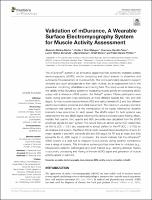Por favor, use este identificador para citar o enlazar este ítem:
https://repositorio.usj.es/handle/123456789/467
| Título : | Validation of mDurance, A Wearable Surface Electromyography System for Muscle Activity Assessment |
| Autor: | Molina-Molina, Alejandro



Ruiz-Malagón, Emilio J. 


Carrillo-Pérez, Francisco 


Roche-Seruendo, Luis Enrique 


Damas, Miguel 


Banos, Oresti 


García-Pinillos, Felipe 


|
| Palabras clave : | Wearable; Electromyography; Knee extension; EMG; Validity; Muscle contraction; mHealth |
| Fecha de publicación: | 27-nov-2020 |
| Editorial : | Frontiers Media S.A. |
| Citación : | Molina-Molina A, Ruiz-Malagón EJ, Carrillo-Pérez F, Roche-Seruendo LE, Damas M, Banos O and García-Pinillos F (2020) Validation of mDurance, A Wearable Surface Electromyography System for Muscle Activity Assessment. Front. Physiol. 11:606287. doi: 10.3389/fphys.2020.606287 |
| Resumen : | The mDurance® system is an innovative digital tool that combines wearable surface electromyography (sEMG), mobile computing and cloud analysis to streamline and automatize the assessment of muscle activity. The tool is particularly devised to support clinicians and sport professionals in their daily routines, as an assessment tool in the prevention, monitoring rehabilitation and training field. This study aimed at determining the validity of the mDurance system for measuring muscle activity by comparing sEMG output with a reference sEMG system, the Delsys® system. Fifteen participants were tested during isokinetic knee extensions at three different speeds (60, 180, and 300 deg/s), for two muscles (rectus femoris [RF] and vastus lateralis [VL]) and two different electrodes locations (proximal and distal placement). The maximum voluntary isometric contraction was carried out for the normalization of the signal, followed by dynamic isokinetic knee extensions for each speed. The sEMG output for both systems was obtained from the raw sEMG signal following mDurance’s processing and filtering. Mean, median, first quartile, third quartile and 90th percentile was calculated from the sEMG amplitude signals for each system. The results show an almost perfect ICC relationship for the VL (ICC > 0.81) and substantial to almost perfect for the RF (ICC > 0.762) for all variables and speeds. The Bland-Altman plots revealed heteroscedasticity of error for mean, quartile 3 and 90th percentile (60 and 300 deg/s) for RF and at mean and 90th percentile for VL (300 deg/s). In conclusion, the results indicate that the mDurance® sEMG system is a valid tool to measure muscle activity during dynamic contractions over a range of speeds. This innovative system provides more time for clinicians (e.g., interpretation patients’ pathologies) and sport trainers (e.g., advising athletes), thanks to automatic processing and filtering of the raw sEMG signal and generation of muscle activity reports in real-time. |
| URI : | https://repositorio.usj.es/handle/123456789/467 |
| ISSN : | 1664-042X |
| Aparece en las colecciones: | Artículos de revistas |
Ficheros en este ítem:
| Fichero | Descripción | Tamaño | Formato | |
|---|---|---|---|---|
| Validation of mDurance, A Wearable Surface Electromyography System for Muscle Activity.pdf | 3,21 MB | Adobe PDF |  Visualizar/Abrir |
Este ítem está sujeto a una licencia Creative Commons Licencia Creative Commons

